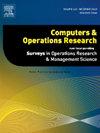设施位置和修复游戏
IF 4.1
2区 工程技术
Q2 COMPUTER SCIENCE, INTERDISCIPLINARY APPLICATIONS
引用次数: 0
摘要
自然灾害发生后,要有效恢复相互依存的基础设施系统,需要电力和电信公用事业等多个基础设施所有者之间进行协调。如果基础设施所有者彼此孤立地做出恢复决定,那么恢复可能是零敲碎打的。从根本上了解这些相互依存关系,可以为激励共同恢复提供启示,从而使所有基础设施用户受益,即使在非合作环境下也能实现社会福利最大化的目标。我们在分层网络上引入了一个非合作设施定位和恢复博弈,其中每一层都属于一个博弈方,以模拟灾后相互依赖的基础设施系统的恢复。该模型的目标是规划短期灾后恢复。每个参与者都希望通过恢复网络组件最大限度地降低满足自身需求的成本。我们提出了设定激励机制(费用)的精确和近似算法,使参与者在均衡状态下的行动与系统的社会最优值一致,从而使总成本最小化。我们在案例研究中考虑了电信基础设施公司的恢复工作,并提供了设施选址和恢复博弈的结果。这些模型和建议的算法可用于制定政策、为机构间互助合作结构提供信息以支持灾后恢复,以及在灾难发生前协商机构间使用费以减轻共同的恢复工作。本文章由计算机程序翻译,如有差异,请以英文原文为准。
Facility location and restoration games
Effective recovery of interdependent infrastructure systems after natural disasters requires coordination between multiple infrastructure owners, such as power and telecommunications utilities. If infrastructure owners make restoration decisions in isolation from one another, then recovery may be piecemeal. A fundamental understanding of these interdependencies can provide insights to incentivize shared restoration that benefit all infrastructure users, with the goal to maximize the social welfare even in a non-cooperative setting. We introduce a non-cooperative facility location and restoration game on a layered network, where each layer belongs to a player, to model the recovery of interdependent infrastructure systems after disasters. The goal of the model is to plan short term post-disaster recovery. The players want to minimize the cost to satisfy their own demand by restoring network components, and each player can serve the other players’ demands if they are paid a fee to do so. We propose exact and approximate algorithms to set incentives (fees) so that the players’ actions at equilibrium are aligned with a social optimum of the system, which minimizes the total cost. We present a case study in which we consider the recovery efforts of telecommunication infrastructure companies and provide results for the facility location and restoration games. The models and proposed algorithms can be used to set policy, inform the structure of inter-agency mutual aid partnerships to support disaster recovery, and negotiate inter-agency usage fees prior to a disaster to ease shared recovery efforts.
求助全文
通过发布文献求助,成功后即可免费获取论文全文。
去求助
来源期刊

Computers & Operations Research
工程技术-工程:工业
CiteScore
8.60
自引率
8.70%
发文量
292
审稿时长
8.5 months
期刊介绍:
Operations research and computers meet in a large number of scientific fields, many of which are of vital current concern to our troubled society. These include, among others, ecology, transportation, safety, reliability, urban planning, economics, inventory control, investment strategy and logistics (including reverse logistics). Computers & Operations Research provides an international forum for the application of computers and operations research techniques to problems in these and related fields.
 求助内容:
求助内容: 应助结果提醒方式:
应助结果提醒方式:


